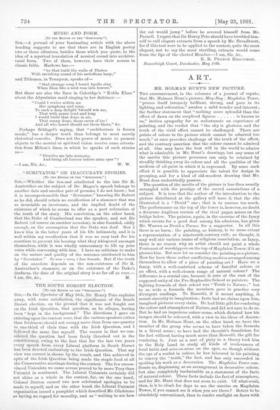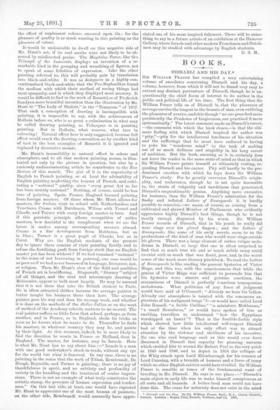ART.
MR. HOLMAN HUNT'S NEW PICTURE.
THE announcement, in the columns of a journal of repute,, that Mr. Holman Hunt's picture, May-Day : Magdalen Tower, " proves itself intensely brilliant, strong, and pure in its lighting and coloration," awakes a mild wonder and interest the further statement that "nothing more splendid than the effect of dawn on the surpliced figures is known to us," invites sympathy for so unfortunate an experience of painting, and the verdict that " the sky is glorious, and the truth of the vivid effect cannot be challenged. There are points of colour in the picture which cannot be admired too much," at once provokes challenge of the truth of the effect, and the contrary assertion that the colour cannot be admired at all. One may have the best will in the world to admire what is admirable in Mr. Hunt's drawings, but any sense of the merits this picture possesses can only be retained by steadily thinking away its colour and all the qualities of the medium of oil-paint in which it is expressed. By some such. effort it is possible to appreciate the talent for design in grouping, and for a kind of old-woodcut drawing that Mr. Hunt does undoubtedly possess.
The question of the merits of the picture is less than usually entangled with the prestige of the sacred associations of a. subject. It is true that the author of the introduction to the picture distributed at the gallery will have it that the rite illustrated is a " Druid" one ; that is to assume too much.. The performance on the top of the tower is, however, no doubt a decorous Anglican version of the rival pagan noises on the bridge below. The painter, again, in the exercise of the fancy which counts for a good deal among his admirers, has given Mr. Warren as Druid a Parsee for a supporter. In all this there is no harm the painting, as history, is to some extent a representation of a nineteenth-century cult ; as thought, it may well stir various trains of religious association; as fancy,. there is no reason why an artist should not paint a whole. Pentecost of worshippers on the top of Magdalen Tower, if it so pleases him. But now let us consider the painting as a picture.. How far have these rather conflicting motives arranged among: themselves to allow of a piece of painting art P Have we a fancy, with a well-contrived scheme of fanciful colour, or• an effect, with a well-chosen range of natural colour P The difference is a crucial one, because it cuts at the root of the supposed unity of the Pre-Raphaelite School as painters. The• fighting formula of that school was " Truth to Nature ;" but. to so wide a formula the members gave in practice very divergent readings. To Rossetti, if it meant anything, it meant sincerity to imagination ; facts had no claims upon him,. imagined pictures every claim. He had little gift for rendering the colour and atmosphere of Nature, and did not care to do so.. But he had an imperious colour-sense, which dictated how his images should be coloured, with a view to his ideas of decora- tion, In Mr. Holman Hunt, on the other hand, we have the member of the group who seems to have taken the formula in a literal sense ; to have had the theorist's fanaticism for the fact without having much more than Rossetti, the gift for- rendering it. Just as a sort of piety to a theory took him to the Holy Land to study all kinds of irrelevances of local habit and mise-en-seine on the spot, so, though without. the_ eye of a realist in colour, he has laboured in his painting. to convey the "truth," the fact, and has only succeeded in. spoiling his work as a decoration. The Magdalen Tower con- fronts us, displeasing as an arrangement in decorative colour, but also completely inadmissible as a statement of the facts. of natural colour. These facts include the fact of atmosphere,. and for Mr. Hunt that does not seem to exist. Of what avail,. then, is it to climb for days to see the sunrise on Magdalen. Tower, if you cannot see it when you are there P Better to be absolutely conventional, than to render sunlight on. faces with the effect of unpleasant colours smeared upon tin ; for the pleasure of quality is as much wanting in this painting as the pleasure of colour.
It would be undesirable to dwell on this negative Bide of Mr. Hunt's art, if its real merits were not likely to be ob- scured by misdirected praise. The Magdalen Tower, like the Triumph of the Innocents, displays an invention of a re- markable kind in the grouping and wreathing of figures, not to speak of some felicities of expression. Like the other painting referred to, this will probably gain by translation into black-and-white. It was as designers in a highly con- ventionalised black-and-white that the Pre-Raphaelites found the medium with which their method of seeing things had most sympathy, and in which they displayed most mastery. It would be difficult to find in the work of Rossetti or of Frederick Sandys a more beautiful invention than the illustration by Mr. Hunt to " The Lady of Shalott," in the " Tennyson " of 1857. That such a conception of drawing is incompatible with painting, it is impossible to say, with the achievement of Holbein before us, who is as great a culmination in what may be called drawing painting, as Velazqnez is in painting painting. But in Holbein, what reserve, what tact in colouring ! Natural effect here is only suggested, because full effect would crack the drawing convention, as by another kind of tact in the best examples of Rossetti it is ignored and replaced by decorative mosaic.
Mr. Hunt's insensibility to natural effect in colour and atmosphere, and to all that modern painting means, is illus- trated not only by the picture in question, but also by a curiously undiscriminating article he contributes to the New Review of this month. The gist of it is the superiority of English to French painting, or at least the advisability of English painting neglecting the lessons of French, and culti- vating a "national " quality, since " every great Art so far has been strictly national." Nothing, of course, could be less true of painting. Spain, France, England learned painting from foreign masters. Of those whom Mr. Hunt allows for masters, Sir Joshua went to school with Netherlanders and Venetians, Crome with Dutchmen, Wilson with Vernet and Claude, and Turner with every foreign master in turn. And if this patriotic principle allows recognition' of native masters, how doubtful is the compliment when we see the havoc it makes among corresponding masters abroad. Crome is a fine development from Hobbema, but so is Diaz ; Turner is a great pupil of Claude, but so is Corot. Why are the English students of the present day to ignore these cousins of their painting family, and to refuse the fertilising graft from foreign stock that no English master yet has been without ? If we had remained "national " in the sense of not borrowing in painting, our case would be as poor as if we had never borrowed in language, literature, law, or religion. Then Mr. Hunt's view of the field and qualities of French art is bewildering. Stagecraft, " literary " subject (of all things), and the neat and microscopic drawing of Meissonier, appear to bulk most largely. He may be assured that it is not these that take the British student to Paris. He is often attracted thither because the average painter is better taught his business there than here. The average painter goes his way and does his average work, and whether it is done on the methods of the Atelier Julian or on the want of method of the Academy schools, matters to no mortal. The real painter suffers as little from that school, perhaps, as from another, and in France, as in England, sheds its tricks as soon as he knows what be wants to do. Thereafter he finds his masters, in whatever country they may be, and paints by their light. At this moment, indeed, be is more likely to find the direction he wants in France or Holland, than in England. The master, for instance, may be Israels. Here is what Mr. Hunt has to say about him :—" Israels is a man with one good undertaker's stock-in-trade, without any eye for the world but what is funereal. In any case, there is no painting in the sense that the work of Titian, Rembrandt, De Hoogh, Reynolds, and Turner is painting; there is no joy of thankfulness in spirit, and no subtlety and profundity of variety in the handling and the treatment of ocular impres- sions. There is not an example of what truly constitutes the artistic stamp, the presence of human expression and tender. nese." On this last side, at least, one would have expected Mr. Hunt to appreciate one of the most human of painters; on the other side, Rembrandt would assuredly have appre- ciated one of his most inspired followers. There will be some- thing to say in a future article of an exhibition at the Hanover• Gallery, where Israels and other modern Frenchmen and Dutch- men may be studied with advantage by English students.
D. S. M.



































 Previous page
Previous page